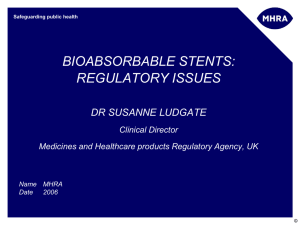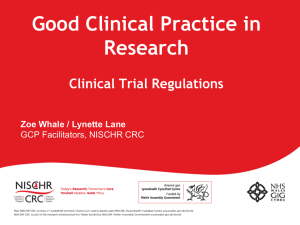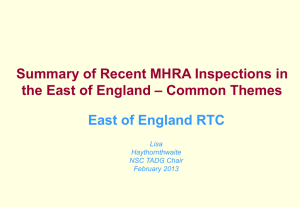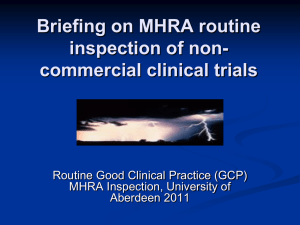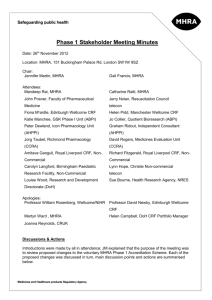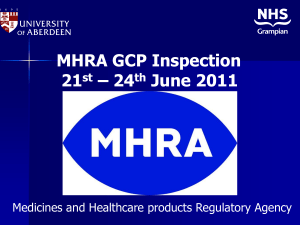Adaptive study design Nice April 2013
advertisement
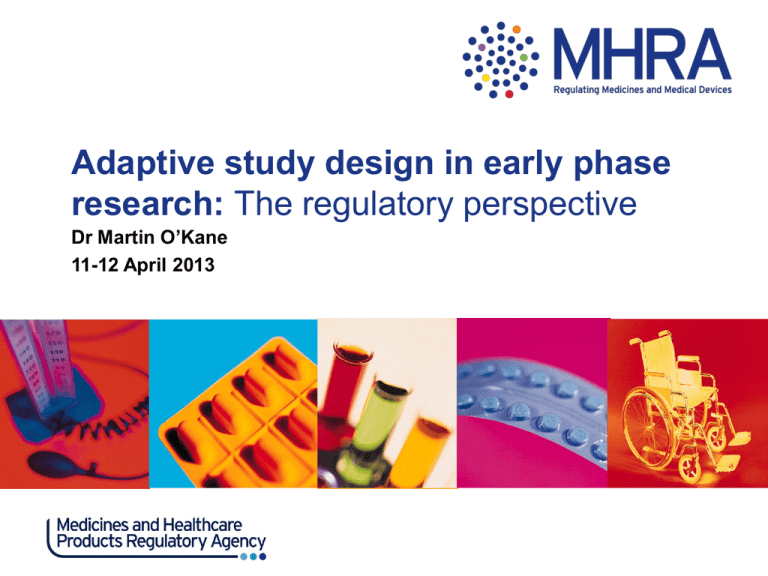
Adaptive study design in early phase research: The regulatory perspective Dr Martin O’Kane 11-12 April 2013 MHRA Family 2 Medicines & Healthcare products Regulatory Agency (MHRA): Regulatory overview • Regulation of medicines - Clinical trials authorisations Marketing authorisations Post marketing safety monitoring Inspections Enforcement and prosecution • Regulation of medical devices - Clinical trial authorisations Overseeing notified bodies Post market surveillance/inspection Enforcement and prosecution • Blood safety and quality - Adverse event reports - Inspections Strategic priorities • Influencing the shape of future EU regulatory framework with a focus on safety surveillance and falsified medicines • Supporting research, innovation and regulation: - simplifying and reducing regulatory burden - supporting strategies that promote life sciences in the UK • Merger with NIBSC • Creating an organisation fit for the future: supporting opportunities arising from the newly expanded organisation. MHRA Clinical Trials Unit – The Clinical Trials Unit is part of the MHRA Licensing Division – – – – – – Product Life-Cycle Assessment Teams (PLATs) Biologicals Unit Clinical Trials Unit (CTU) Product Licensing – Parallel Imports Unit (PLPI) Statistics Unit Expert Committee Support and Service Management (ECSSM) MHRA Clinical Trials Unit – We assess all applications to conduct interventional clinical trials with investigational medicinal products in the UK • Phase I-IV, including FTIH • Chemical, Biotech, ATMPs – We assess the initial application to conduct a trial – We assess substantial amendments to the protocol and product – We review safety reports – We liaise with other MHRA Units: • Licensing colleagues • GxP Inspectors • Committee Support MHRA CTU experience with adaptive study designs What do we mean by “adaptive study design”? • Adaptive protocol Vs ‘umbrella/bundle’ protocol? • EMA: A study design is called “adaptive” if statistical methodology allows the modification of a design element (e.g. sample-size, randomisation ratio, number of treatment arms) at an interim analysis with full control of the type I error. • FDA: a study that includes a prospectively planned opportunity for modification of one or more specified aspects of the study design and hypothesis based on analysis of (interim) data from subjects in the study • Other: any design which uses accumulating data to decide how to modify aspects of the study without undermining the validity and integrity of the trial. • Uses prospective decisions – adaptations are ‘by design’ not ‘ad hoc’ Does the MHRA accept adaptive protocol design? Yes! Supporting research and innovation is one of our key strategic priorities. • We are open to suggestions • The onus is on the sponsor to provide clear and justified risk mitigation proposals in the protocol. • Note: MHRA CTU assesses the protocol in terms of safety of the proposed trial and may not have insight on proposed development of the product for MA (i.e. the merits of the individual trial are assessed) scientific advice is available for questions on the development plan. At which stage? • Exploratory? • Probably most common at this stage • Mainly ‘umbrella’ protocols • Seamless’ Phase II / III combinations? • Not as common • Depends on the study • E.g. ‘dropping’ arms • will a ‘proper’ PIII be needed for MA?? Are adaptive designs common? • Concept has been around for a long time! • MHRA CTU see mostly ‘umbrella / bundle’ types (“true” adaptive design protocols are relatively rare) • Time of licensing – still not common to support MA How far can you go? • When is an amendment required? – In a lot of respects this is up to the sponsor – single dose multiple dose? • Scientific advice meeting – NCA / EMA? – Not normally required by MHRA. If the sponsor wants specific advice in terms of development or if the design is very novel then it is a good idea to speak to the regulators. • EAG / CHM review? – The protocol design in itself would not lead to the need for independent expert review. This would be a down to risk factors associated with the IMP. Are adaptive designs easier or harder to review from a MHRA perspective? • There is more to assess in the same timeframe as a single part protocol – But we have no prejudice against them! • Are they harder or easier to write and perform?! What issues can you face? If the protocol is not written explicitly: • There is the potential for an increased number of grounds for nonacceptance • advantages are that if the GNAs are answered satisfactorily you are good to go and it will always be quicker than submitting separate submissions. • if GNAs are not answered satisfactorily rejection (resubmission) • Might be required to submit amendments • Regulatory risks depend on the regulatory role of the study – will it be used for basis of MA approval? • Scientific risk – if there is no regulatory risk the sponsor will bear the scientific risk • Logistical issues: e.g accountability/return of IMP from a dropped arm What could applicants do better? • Be clear and explicit in the protocol (define and justify!) • We cannot assume or give benefit of the doubt In general: if an assessor can read the protocol and know what will happen to subjects from the start to the finish of the study then there’s a good chance there will be few issues (this doesn’t imply that it will approved!) Are there any guidance documents? Just one EU document to date: • REFLECTION PAPER ON METHODOLOGICAL ISSUES IN CONFIRMATORY CLINICAL TRIALS PLANNED WITH AN ADAPTIVE DESIGN CHMP/EWP/2459/02 (Adopted 2007) This is referenced in many recent guidance documents FDA Draft Guidance: • Guidance for Industry. Adaptive Design Clinical Trials for Drugs and Biologics (February 2010) Are there differences in approach in different EU MS (or in USA)? • Clinical trials authorisations are a National Competence • There are initiatives to harmonise decisions across EU: e.g. You might consider the Voluntary Harmonisation Procedure (VHP) EU Multi-national clinical trials: current situation communication time outcome + + sponsor + + NCAs EU Multi-national clinical trials: VHP time communication outcome + sponsor (or -) VHP-C P-NCAs VHP • Three Phases: 1. Request/validation 2. VHP Assessment 3. National CTA application submission 120 No/year 100 80 60 40 20 0 2009 2010 2011 2012 VHP Advantages – Single application • One set of core documentation • No MS-specific requirements • Fixed timelines – Single, consolidated set of questions • GNAs reduced by up to average of 50% – Harmonised scientific discussion in the Member States concerned • Addresses many criticisms of Clinical Trials Directive • Don’t need to wait for new legislation Summary – tips for submitting an adaptive protocol design • Golden rule: The protocol should be written such that the assessor has a clear understanding of what data will be used to make the adaptations proposed in the study. • Sometimes things “need said” (don’t rely on the assessor to make the judgement for you) • If you are considering an EU MN-CT the VHP route may be worthwhile • If the protocol design is truly novel, consider seeking scientific advice from MHRA CTU ± Licensing colleagues
